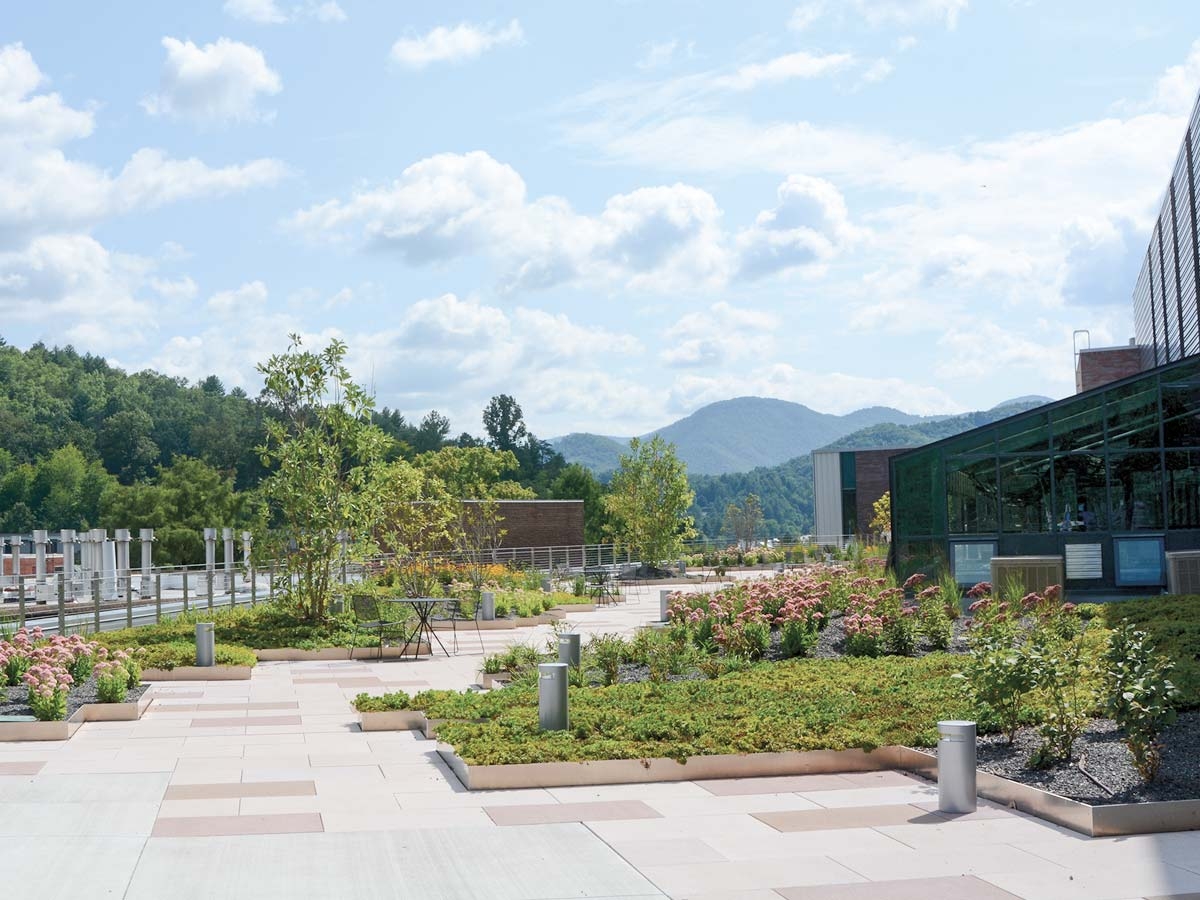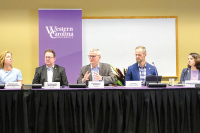Training tomorrow’s scientists: WCU opens $110.5 million science building
 A rooftop terrace offers sweeping views of campus, native plant gardens and a convenient spot for astronomy observations. Holly Kays photos
A rooftop terrace offers sweeping views of campus, native plant gardens and a convenient spot for astronomy observations. Holly Kays photos
Until 2016, then-Chancellor David O. Belcher spent much of his time and energy as leader of Western Carolina University in Cullowhee telling anyone who would listen that WCU’s future was in danger. Specifically, the future of its engineering, science and nursing programs.
The reason for that danger was an aging natural sciences building that was too small to accommodate the growing number of students pursuing science careers, vibrated so significantly when the air conditioning units kicked on that using sensitive scientific equipment was impossible, and dealt constantly with mold, plumbing and storage issues.
Last week, the university community celebrated the grand opening of a $110.5 million, 189,000-square-foot building that serves as the ultimate answer to the questions Belcher began asking years ago.
“It truly takes a village for a project such as this,” current Chancellor Kelli R. Brown told a crowd of more than 250 people gathered under sunny skies Friday, Sept. 3, to dedicate the brand new Tom Apodaca Science Building, now home to the university’s biology, chemistry, physics and forensic science programs.
Inside the building
Sunshine — both physical and metaphorical — is a key component of the new building’s design.
Related Items
“Our goal in building the Apodaca Science Building was not only to replace the old natural sciences building with a safer building with updated systems and amenities, although we really needed that, but to create a building that better represented how we do science,” said College of Arts and Sciences Dean David Kinner.
Science is an active, collaborative and inclusive process, he said, so it was important for the building to offer students the chance to learn, study and research alongside professors, graduates and undergraduate students.
“Many of our WCU students will come here to study diverse topics from the magnificence of the universe to the complexity of the human body,” Kinner said. “Hopefully students will also be able to understand the scientific process, the continued work of asking and answering questions, always moving steadily closer to truth. Students will also hopefully know the ability of science, and even our student scientists, to provide important information and breakthroughs for society which when leveraged effectively, conserve us all.”
As the dedication ceremony unfolded, clouds swirled above reflected mountain curves on the building’s many glass panels. Indoors, that natural light illuminated study nooks, classrooms, labs and even hallways — many labs and classrooms have glass on both sides, allowing the sun to reach interior spaces.
The coming years will be even brighter, as the old science building still stands next to the new one, in places just a handful of feet away from the windows. Demolition is scheduled for October.
“I come here before class every morning to do homework,” said senior English and biology student Melissa Rogers, gesturing toward one of the couches lining the inside walls of the bright, curved lobby area, as she led a tour of the new building.
The building’s largest room is a 150-person auditorium on the ground floor. The chairs are removable, so the space can also be used for receptions and other gatherings when class isn’t in session. A large piece of artwork outside the auditorium honors the Cherokee legacy of the site, while historical photos of WCU and the Cullowhee area line the hall.
A set of stadium-style concrete steps pay homage to another one of the site’s former uses — a pre-Whitmore football stadium — and lead up to the third of the building’s five floors of public space. The first through fourth floors also feature an interior connection to the adjacent Stillwell Science Building.
There’s an instrumentation lab featuring an NMR machine that Rogers refers to as “the spaceship,” pointing out the red posts surrounding it to keep people away from its magnetic field, as well as labs for ancient DNA analysis, molecular biology and more, with organismal studies concentrated on the fifth floor. The fifth floor is also home to a rotating display featuring a subset of the 47,000 items in the university’s collection of plant and animal specimens.
Collaboration is central to the building’s design. Professors have workstations in shared labs, and student study space is intentionally placed near faculty offices — something that Rogers said she particularly loves about the building.
The crown jewel, though, is undeniably the fifth-floor terrace that offers a sweeping view of WCU’s campus and the mountains surrounding it, all within walkways surrounded by flowerbeds containing a cacophony of native plants. The terrace will also prove useful for astronomy observations, and a greenhouse nestled in among the beds takes further advantage of the sunlight.
“This building will serve generations of students,” said Kinner, “but it also serves as a reminder of what we can collectively accomplish as a campus.”

Former Sen. Tom Apodaca stands with his grandson Rio in front of the new science building bearing his name.
Apodaca’s contribution
While Belcher started beating the drum signifying the “dire straits” Western was in with its former science building, Brown said, it was the voters of North Carolina, the N.C. General Assembly and especially then-Sen. Tom Apodaca (R-Hendersonville) who made the solution possible. The building was funded through the Connect N.C. Bond, which voters approved in a March 2016 referendum vote.
At $110.5 million, the science building was by far the biggest-ticket item funded through the $2 billion bond , and according to those gathered on the science building’s courtyard Friday, Sept. 3, Apodaca had a lot to do with that outcome.
“Senator Tom Apodaca, in partnership with the late Chancellor Belcher and an understanding of our needs, stood fast over the course of the next 18 months (leading up to the referendum), at times in the teeth of great political pressure, to ensure that Western Carolina University’s sorely needed science building not only remained in the Connect N.C. Bond, but that the full project cost was sustained and not reduced before the bond was included on the ballot in March of 2016,” Brown said. “It is for that reason, and for the countless initiatives that Senator Apodaca shepherded to the benefit of WCU that we honor him with his name permanently associated with this beautiful and transformative building.”
Himself a WCU alum — as are his wife and two sons — Apodaca comes by his dedication to the university honestly. In the years since he graduated in 1980, Apodaca has served on the WCU Board of Trustees and established multiple scholarships.
“Perhaps the most impactful contribution Tom has made to this university was in his support of WCU during his time in the N.C. Senate,” said Board of Trustees Chairman Bob Roberts at the ceremony.

Large windows on the fifth floor of the Apodaca Science Building offer a panorama of campus and the mountains framing it.
During his 14 years in state government, Apodaca supported various pieces of legislation to build and renovate campus facilities — including the infamous steam plant — and, perhaps most notably, was a vocal proponent of the N.C. Promise Tuition Program, which reduced the price of undergraduate tuition for in-state students to $500 per semester at WCU and two other University of North Carolina schools.
Senate President Pro Tem Phil Berger said that it’s no surprise that Apodaca’s getting a building named after him — but that he is surprised by which building it turned out to be.
“A lot of us were looking at each other and saying, ‘We’re going to name a building after Tom. We’d like to see the trustees name a building after Tom,’” he said. “Nobody said science building. Everybody said steam plant.”
The comment drew a sustained laugh from the crowd, but when he followed Berger at the podium Apodaca said he’s proud of the entirety of the work he’s done on WCU’s behalf.
“Every path I’ve taken in my life started here at WCU,” he told the crowd. “And I feel that with all my heart.”













